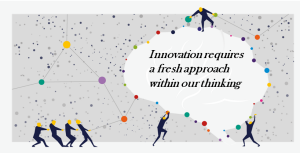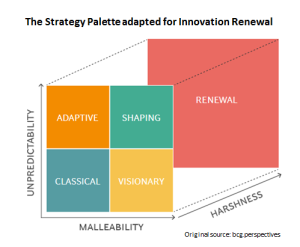 I certainly believe we are in need of a fresh approach to innovation. We are facing unprecedented challenges, sluggish growth and increasing competition from unexpected sources.
I certainly believe we are in need of a fresh approach to innovation. We are facing unprecedented challenges, sluggish growth and increasing competition from unexpected sources.
We need to increasingly deliver better end results; as more distinctive, bolder and creative, delivering greater value to our customers’ needs. Can we change our thinking to achieve this?
Let me offer some of my thoughts on why we need to reinvent our innovation management.
The power of technology, software and the use of the cloud is combining in new powerful ways. We are looking for greater data capture and analytics and this is offering us a very different set of options than in the past. The framing of the innovation potential has to be altered. Altered in different products. services and business models. But will it?
Yet many organisations still stay locked into their established ways, systems and structures. Many organisations are failing to renew themselves. Innovation seems to be trapped in the past, we need a new framing to break it out and make it more dynamic and adaptive to meeting constantly changing needs.
Innovation needs to become far more responsive and dynamic, to respond with imagination and intent of purpose.
To achieve this innovation requires a greater organisational engagement than ever before. It needs mobilising differently, in radically different ways; to capture different opportunities in more agile, adaptive and shaping ways.
Often we look at innovation through a single lens but it does need to accommodate different dimensions that can be exploratory or exploitive, we need to both widen the aperture of the lens and simultaneously change lens to view things differently.
We certainly need far more “mission-orientated” innovation, that is both converging and synergistic, strategically aligned, building on the back of past work and ‘sunk’ investment but equally, pushing out in new ways. Innovation should be constantly renewed and refreshed, it needs investments for its future.
Rapidly changing market conditions are challenging us more
Our portfolio of innovation offerings is facing different market conditions. Some of our products and services are in stable and predictable market conditions, others are being subjected to significant change, caused by technology, adapting to new emerging trends or changing demands and shifting regulations. All of these can challenge the existing business and we need to respond in different ways and at different speeds.
This also seems a time where there is increasing opportunity to shape industry evolutions through multiple ways and use of the many technology enablers, in exploring new relationships, investing in networks and platforms to collaborate and extend beyond our own restricted abilities. All of this requires a greater adaptive and shaping capability. For this, we need a far greater innovation translation canopy to explore. A new framework. Actually ‘multiple’ frameworks.
Applying The Strategy Palette to our Innovation Needs
 Initially provided by BCG as a strategy palette, I have set about adopting this framework to innovation.
Initially provided by BCG as a strategy palette, I have set about adopting this framework to innovation.
I initially wrote in “Shining a powerful innovation light into the Corporate board rooms” about the application and value of this frame differently. The difference is that mine is an Innovation Strategic Palette by applying its use in developing the innovation strategic content that boardrooms need to build better, clearer and far more comprehensive innovation strategies.
We can apply this to change our innovation thinking, to make it more versatile to what we need from our innovation today. It can open up our thinking and allow us to gain a revised understanding of how innovation can be mobilised in different ways.
By applying this framework through four archetypes alternatives, you can see emerging different design options to innovation. Choices that can provide the catalyst that can drive innovation’s renewal. It really can be used as a problem recognition diagnostic tool or a starting point for innovation opportunity dialogues .
We are in need of finding innovation frameworks that can guide, seize and respond to emerging opportunities quicker, at today’s new innovation speed in agile ways. Exploring this palette framework has to be valuable, to offer a new flexible approach to dealing with these multiple forces of upheaval and threat with clear intent and design in response.
Why this call for innovation renewal? Why do we need to re-think our approach to innovation?
Firstly the need for consistent renewal
We need to constantly renew within ourselves, that seem a constant today and our innovation efforts need a serious renewal for many reasons. We are facing unprecedented challenges, complexities and competition. We are mostly facing sluggish growth and find an increasing new competition from unexpected sources, looking to disrupt established markets, probing to change the game, innovation has an urgent need to adjust to a whole new set of different business dynamics.
Where and when do we invest, why and how? The need for different handling and thinking
Knowing when and where to invest in an innovation renewal and organising for it is a tough call. It tends to fly in the face of excepted practices, based on constantly attempting to improve the efficiencies and effectiveness of the processes. Often innovation discovery is unique, the pursuit of bringing innovation from discovery through to commercialization has many unknowns and inconsistencies of practices.
Innovation and its management are hard to align into much of the established practices and this is one of its toughest tests; to be treated differently not attempted to be drawn into other organizational activity by applying a mixture of routines and linear handoff, it needs mobilizing in different ways, to capture different opportunities in more agile, adaptive and shaping ways.
Innovation needs a different handling, more adaptive, more discovery-orientated, more exploratory, testing and probing to validate concepts and ideas.
Addressing the changing market conditions through different innovation design.
Why I think this BCG strategic palette has it ‘bang on’ is in the fact they recognize that business environments have three discernible dimensions: predictability and how you can forecast it, malleability and how you shape it, alone or in collaborative ways, and the harshness of the existing market conditions and how you set about surviving this. It is how you set about executing innovation outcomes within these three dimensions will give that greater distinctive need to the design and execution of your innovation solutions. Just thinking about the prevailing conditions can alter perceptions.
The framing of our innovation does have serious strategic consequences.
Those that are honest enough to admit that what they have achieved to-date in innovation activity is just not going to ‘cut it’ for the future, will be making a very ‘tough’ call but it might be one of the best ones they are about to make. It opens up the thinking to let alternatives in.
I think we all need to constantly look at a renewal of innovation as essential in our thinking, as the conditions we operate within are more volatile than ever before. Over shorter times many things have evolved, suddenly changed, altered and moved on. So by not constantly refreshing we have allowed systems and tools to stay stuck in the past, we stay ‘bound’ to innovation in a current format often far too long. We need to shake out the cobwebs and renew ourselves.
The innovation spirit needs rethinking by taking a more versatile and shaping approach
We fail to constantly refresh and challenge our understanding. We need not just to adjust to our goals but more importantly to adjust from our knowledge of understanding of how we are managing innovation. We simply do need new and different framing mechanisms to be applied constantly as we set about innovation design if we believe in growth and fresh value creation.
It takes a real innovation zeal to renew, thinking this through in different new ways. Renewing innovation needs recognition. Focusing on renewal offers much. Don’t just rip-up or simply dispose of what we have, think through what renewing can give us in improved solutions, often at much lower cost and customer acceptance but most critically to decide and balance the different speeds and challenges innovation development has. Innovation and its management need to be thought through afresh.
Framing our thinking towards our future needs of innovation relates to the conditions we face today and can possibly foresee coming towards us. These conditions of ‘being’ predictable and unpredictable’ begins to determine the type of innovation approach to take.
We need to be fluid, flexible and have different mindsets of thinking innovation.
The approach we take is offering up this mix of the classical, the visionary, the adaptive and shaping and from these first we need to decide the tools, frameworks, resources, structures and systems that best work in each case, the what is applicable to bring to fruition different ideas within each of these dimensions offered in the palette.
We also need to recognise that innovation is different each time, for each opportunity, where it needs resourcing and managing differently. This BCG strategic palette approach can offer a framework that does offer us a broader variety of options in our innovation thinking.
We also need to recognise that innovation is different each time, for each opportunity, where it needs resourcing and managing differently. This BCG strategic palette approach can offer a framework that does offer us a broader variety of options in our innovation thinking.
Shifting our thinking
We must move away from a one-size fit all mentality, one where all innovation ‘chugs’ along, within the same process and pipeline. At present this copnstraining approach is killing so much of the potential within innovation. How can all those distinctive, radical and breakthrough concepts, all trying to be measured, squeezed and determined by one processing lens of innovation, all being constrained by traditional thinking, never ever seeing the light of day, as commercial outcomes because we ‘kill them off’?
Exploring different framing mechanisms are necessary
We not only need to apply the three horizons thinking for building and allocating our innovation to different time horizons but I would suggest we need to apply this BCG palette approach for our innovation approaches.
We need to break out of this current mindset trap of one-dimensional thinking, into that dual one of wanting to be simultaneously exploring and exploiting, managing the known and seeking out answers to the unknowns, keeping a balance between today’s business and those concepts that can grow for our future and that will need constant renewal, questioning and evaluation.
We do need new framing mechanisms to be applied to our innovation design and I just feel this palette frame can make a useful contribution as we apply different thinking to redesigning innovation in need of this renewal.